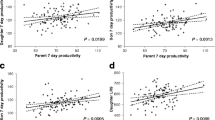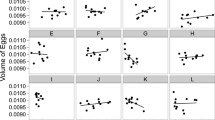Abstract
Many organisms have been reported to choose their mates in order to increase the heterozygosity of their offspring by avoiding mating with relatives or homozygous individuals. Most previous studies using Drosophila melanogaster have used artificial chromosomes or extreme inbreeding treatments, situations unlikely to be matched in nature. Additionally, few studies have examined the interaction between female inbreeding status and her choice of mate. Using females and males from populations that had experienced either random mating or one generation of sib-sib inbreeding, we measured the preferences of females for males. Our results indicate that outbred males were chosen more often than inbred males and that this preference may be more pronounced in outbred females than in inbred ones.



Similar content being viewed by others
References
Andersson M (1994) Sexual selection. Princeton University Press, Princeton
Aparicio JM, Cordero PJ, Veiga JP (2001) A test of the hypothesis of mate choice based on heterozygosity in the spotless starling. Anim Behav 62:1001–1006
Beltran S, Cézilly F, Boissier J (2008) Genetic dissimilarity between mates, but not male heterozygosity, influences divorce in schistosomes. PLoS ONE 3:e3328
Bolund E, Martin K, Kempenaers B, Forstmeier W (2010) Inbreeding depression of sexually selected traits and attractiveness in the zebra finch. Anim Behav 79:947–955
Bonneaud C, Chastel O, Federici P, Westerdahl H, Sorci G (2006) Complex Mhc-based mate choice in a wild passerine. Proc R Soc B 273:1111–1116
Brown JL (1996) A theory of mate choice based on heterozygosity. Behav Ecol 8:60–65
Burley NT, Foster VS (2006) Variation in female choice of mates: condition influences selectivity. Anim Behav 72:713–719
Carter AJR, Houle D (2011) Artificial selection reveals heritable variation for developmental instability. Evolution 65:3558–3564
Carter AJR, Osborne E, Houle D (2009a) Heritability of directional asymmetry in Drosophila melanogaster. Int J Evol Biol 2009:759159
Carter AJR, Weier TM, Houle D (2009b) The effect of inbreeding on fluctuating asymmetry of wing veins in two laboratory strains of Drosophila melanogaster. Heredity 102:563–572
Charlesworth D, Charlesworth B (1987) Inbreeding depression and its evolutionary consequences. Ann Rev Ecol Syst 18:237–268
Darwin CR (1871) The descent of man and selection in relation to sex. John Murray, London
Darwin CR (1876) The effects of cross and self fertilization in the vegetable kingdom. John Murray, London
De Luca PA, Cocroft RB (2008) The effects of age and relatedness on mating patterns in thornbug treehoppers: inbreeding avoidance or inbreeding tolerance? Behav Ecol Sociobiol 62:1869–1875
Dukas R (2005) Learning affects mate choice in female fruit flies. Behav Ecol 16(4):800–804
Ferretti V, Massoni V, Bulit F, Winkler DW, Lovette IJ (2011) Heterozygosity and fitness benefits of extrapair mate choice in white-rumped swallows. Behav Ecol 6:1178–1186
Fox CW, Xu J, Wallin WG, Curtis CL (2012) Male inbreeding status affects female fitness in a seed-feeding beetle. J Evol Biol 25:29–37
Frommen JG, Bakker TCM (2006) Inbreeding avoidance through non‐random mating in sticklebacks. Biol Lett 2:232–235
García-Navas V, Ortego J, Sanz JJ (2009) Heterozygosity-based assortative mating in blue tits (Cyanistes caeruleus): implications for the evolution of mate choice. Proc R Soc B 276:2931–2940
Gerloff CU, Schmid-hempel P (2005) Inbreeding depression and family variation in a social insect, Bombus terrestris (Hymenoptera: Apidae). Oikos 1:67–80
Griggio M, Biard C, Penn DJ, Hoi H (2011) Female house sparrows “count on” male genes: experimental evidence for MHC-dependent mate preference in birds. BMC Evol Biol 11:44
Guevara-Fieore P, Rosenqvist G, Watt PJ (2010) Inbreeding level does not induce female discrimination between sibs and unrelated males in guppies. Behav Ecol Sociobiol 64:1601–1607
Hoffman JI, Forcada J, Trathan PN, Amos W (2007) Female fur seals show active choice for males that are heterozygous and unrelated. Nature 445:912–914
Houle D, Mezey J, Galpern P, Carter AJR (2003) Automated measurement of Drosophila wings. BMC Evol Biol 3:25
Ilmonen P, Stundner G, Thoss M, Penn DJ (2009) Females prefer the scent of outbred males: good-genes-as-heterozygosity? BMC Evol Biol 9:104
Jennions MD, Petrie M (1997) Variation in mate choice and mating preferences: a review of causes and consequences. Biol Rev 72:283–327
Kempenaers B (2007) Mate choice and genetic quality: a review of the heterozygosity theory. Adv Study Behav 37:189–278
Kokko H, Ots I (2006) When not to avoid inbreeding. Evolution 60:467–475
Laloi D, Eizaguirre C, Fédérici P, Massot M (2011) Female choice for heterozygous mates changes along successive mating in a lizard. Behav Process 88:149–154
Lynch M, Walsh B (1998) Genetics and analysis of quantitative traits. Sinauer Associates Inc., Sunderland
Marques I, Feliner GN, Martins-Loução MA, Aguilar JF (2011) Fitness in Narcissus hybrids: low fertility is overcome by early hybrid vigour, absence of exogenous selection and high bulb propagation. J Ecol 99:1508–1519
Masters KL, Masters AR, Forsyth A (1994) Female-biased sex ratios in the neotropical treehopper Umbonia ataliba (Homoptera: Membracidae). Ethology 96:353–366
Mazzi D, Künzler R, Largiadèr CR, Bakker TCM (2004) Inbreeding affects female preference for symmetry in computer‐animated sticklebacks. Behav Genet 34:417–424
Miller RS, Glasner J, Hedrick RW (1993) Inbreeding depression and male-mating behavior in Drosophila melanogaster. Genetica 88:29–36
Mueller LD, Joshi A, Santos M, Rose M (2013) Effective population size and evolutionary dynamics in outbred laboratory populations of Drosophila. J Genet 92(3):349–361
Nepoux V, Haag CR, Kawecki TJ (2010) Effects of inbreeding on aversive learning in Drosophila. J Evol Biol 23:2333–2345
Pai A, Yan G (2002) Female mate choice in relation to heterozygosity in Tribolium castaneum. J Evol Biol 15:1076–1082
Palmer CA, Edmands S (2000) Mate choice in the face of both inbreeding and outbreeding depression in the intertidal copepod Tigriopus californicus. Mar Biol 136:693–698
Pelabon C, Hansen TF, Carter AJR, Houle D (2010) Evolution of variation and variability under fluctuating, stabilizing, and disruptive selection. Evolution 64(7):1912–1925
Pölkki M, Krams I, Kangassalo K, Rantala MJ (2012) Inbreeding affects sexual signaling in males but not females of Tenebrio molitor. Biol Lett 8:423–425
Quilichini A, Debussche M, Thompson JD (2001) Evidence for local outbreeding depression in the Mediterranean island endemic Anchusa crispa Viv. (Boraginaceae). Heredity 87:190–197
Reusch TBH, Häberli MA, Aeschlimann PB, Milinski M (2001) Female sticklebacks count alleles in a strategy of sexual selection explaining MHC polymorphism. Nature 414:300–302
Ryder TB, Tori WP, Blake JG, Loiselle BA, Parker PG (2009) Mate choice for genetic quality: a test of the heterozygosity and compatibility hypotheses in a lek-breeding bird. Behav Ecol 21:203–210
Seko T, Miyatake T, Miura K (2012) Assessment of hybrid vigor between flightless lines to restore survival and reproductive characteristics in the ladybird beetle Harmonia axyridis. BioControl 57:85–93
Shahid MQ, Hai-Ming X, Shun-Quan L, Zhi-Xiong C, Naeem M, Ya-Juan L, Xiang-Dong L (2012) Genetic analysis and hybrid vigor study of grain yield and other quantitative traits in autotetraploid rice. Pak J Bot 44(1):237–246
Sherman CDH, Wapstra E, Uller T, Olsson M (2008) Males with high genetic similarity to females sire more offspring in sperm competition in Peron’s tree frog Litoria peronii. Proc R Soc B 275:971–978
Smith SB, Webster MS, Holmes RT (2005) The heterozygosity theory of extra-pair mate choice in birds: a test and a cautionary note. J Avian Biol 36:146–154
Suvanto L, Liimatainen JO, Tregenza T, Hoikkala A (2000) Courtship signals and mate choice of the flies of inbred Drosophila montana strains. J Evol Biol 13:583–592
Tan CKW, Løvlie H, Pizzari T, Wigby S (2012) No evidence for precopulatory inbreeding avoidance in Drosophila melanogaster. Anim Behav 83:1433–1441
Taylor ML, Wedell N, Hosken DJ (2007) The heritability of attractiveness. Curr Biol 17(22):R959–R960
Thünken T, Baldauf SA, Kullmann H, Schuld J, Hesse S, Bakker TCM (2011) Size-related inbreeding preference and competitiveness in male Pelvicachromis taeniatus (Cichlidae). Behav Ecol 22:358–362
Tien NSH, Massourakis G, Sabelis MW, Egas M (2011) Mate choice promotes inbreeding avoidance in the two-spotted spider mite. Exp Appl Acarol 54:119–124
Välimäki P, Kivelä SM, Mäenpää MI (2011) Mating with a kin decreases female remating interval: a possible example of inbreeding avoidance. Behav Ecol Sociobiol 65:2037–2047
Viken A, Fleming I, Rosenqvist G (2006) Premating avoidance of inbreeding absent in female guppies (Poecilia reticulata). Ethology 112:716–723
Vorsino AE, Wieczorek AM, Wright MG, Messing RH (2012) An analysis of heterosis and outbreeding depression among lab-reared populations of the parasitoid Diachasmimorpha tryoni (Cameron) (Hymenoptera: Braconidae); potential implications for augmentative release. Biol Control 61:26–31
Wetzel D, Westneat D (2009) Heterozygosity and extra-pair paternity: biased test results from the use of shared markers. Mol Ecol 18:2010–2021
Zajitschek SRK, Brooks RC (2010) Inbreeding depression in male traits and preference for outbred males in Poecilia reticulata. Behav Ecol 4:884–891
Acknowledgments
We would like to thank Alma Madrigal for her knowledge of fly maintenance, Kriska Parda for help with fly observations, and Julio Castro for the development of the mating contraptions used in this experiment. We would like to thank Michael Rose for supplying the Rose line. This research was funded by the Research Initiative for Scientific Enhancements, grant number 07298409. We also thank the anonymous reviewers of our manuscript for their suggestions.
Author information
Authors and Affiliations
Corresponding author
Rights and permissions
About this article
Cite this article
McKee, A.A., Newton, S.M. & Carter, A.J.R. Influence of Inbreeding on Female Mate Choice in Two Species of Drosophila . J Insect Behav 27, 613–625 (2014). https://doi.org/10.1007/s10905-014-9453-5
Revised:
Accepted:
Published:
Issue Date:
DOI: https://doi.org/10.1007/s10905-014-9453-5




